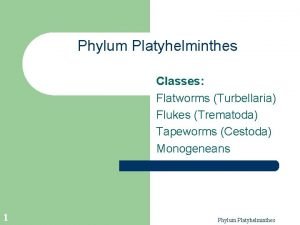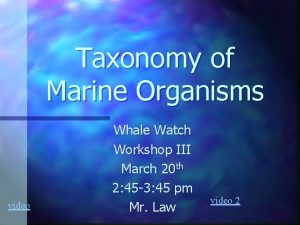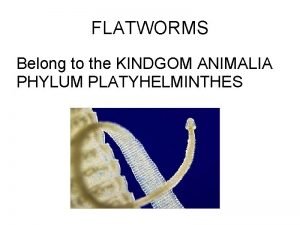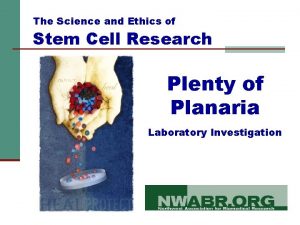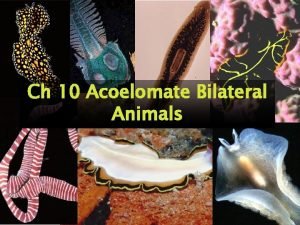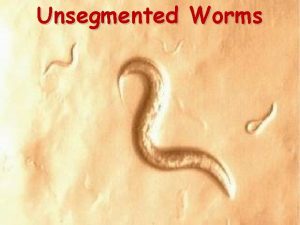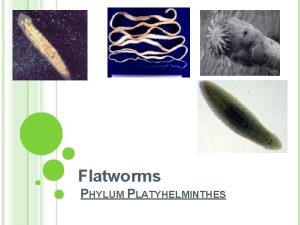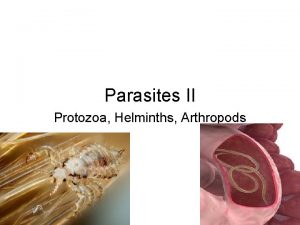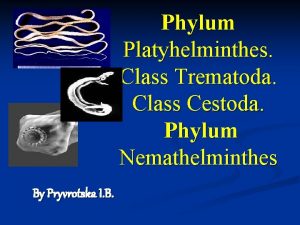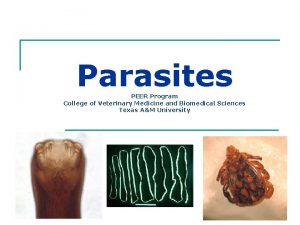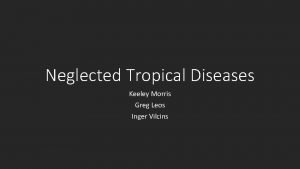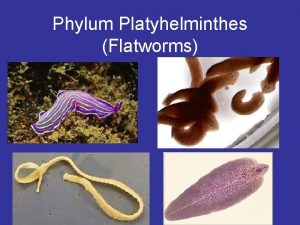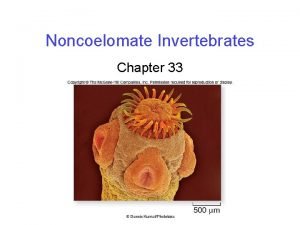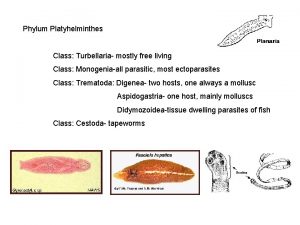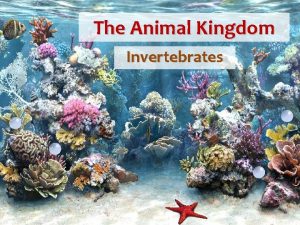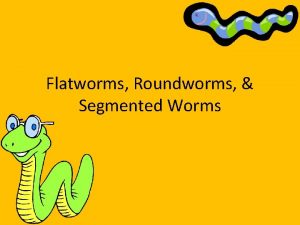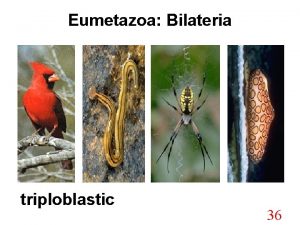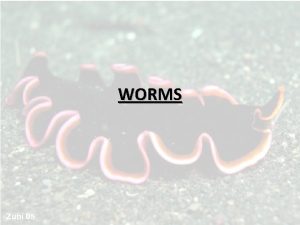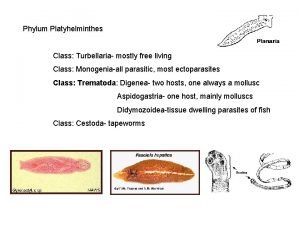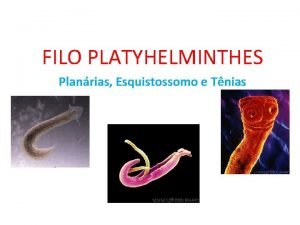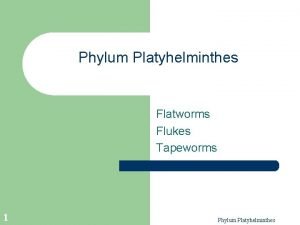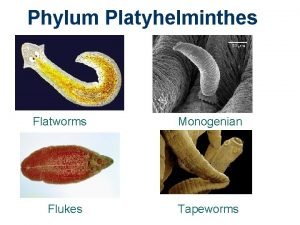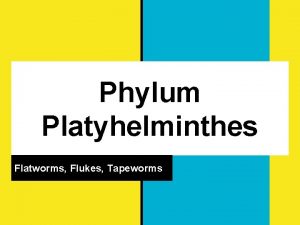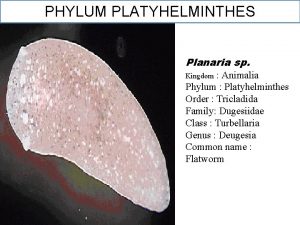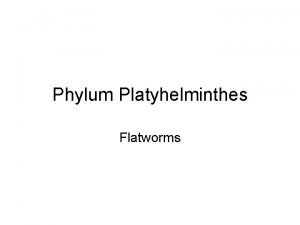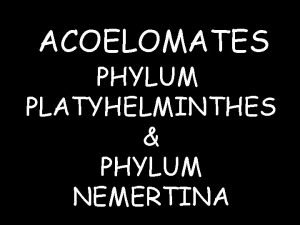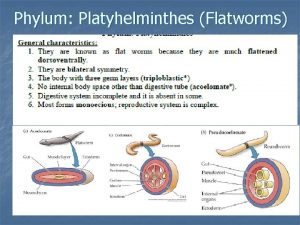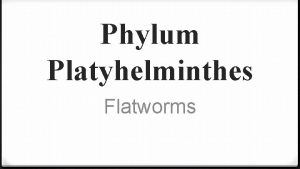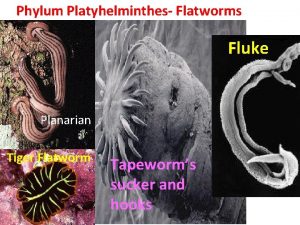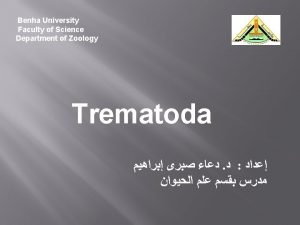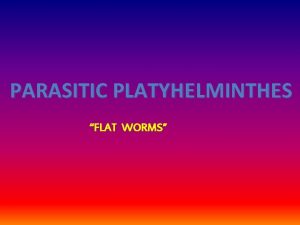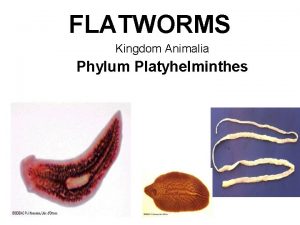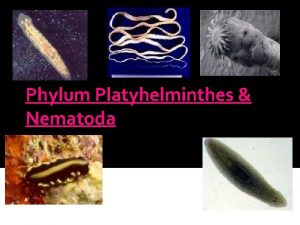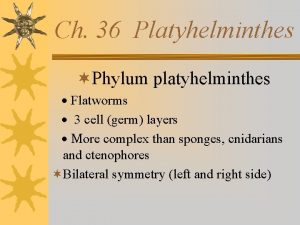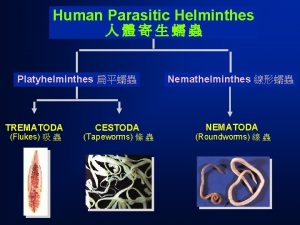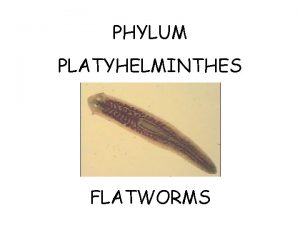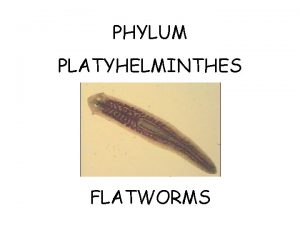PHYLUM PLATYHELMINTHES Flatworms Planaria Flukes Tapeworms FACT Longest






















- Slides: 22

PHYLUM PLATYHELMINTHES (Flatworms) Planaria Flukes Tapeworms FACT: Longest human tapeworm = 12 meters long Longest tapeworm = 40 meters long

PLATYHELMINTHES l platy l l helminthes l l Greek for “worm” moving “up” the ladder of evolution l l l Greek for “flat” more complex than Porifera and Cnidaria however, through evolution has simplified Three Classes l l l Class Turbellaria – example planaria Class Trematoda – example flukes Class Cestodae – example tapeworms

PLATYHELMITHES l MULTICELLULAR l l l cells are specialized and organized into tissues and organs have sensory organs concentrated at anterior (head) end = cephalization GERM LAYERS l have endoderm , ectoderm and mesoderm l Endoderm – forms inner gut l Ectoderm – forms outer epidermis l Mesoderm - forms muscle tissue and reproductive, and excretory organs

PLATYHELMINTHES l MOVEMENT l l Some larval stages move using cilia Adults move using muscle contractions http: //www. youtube. com/watch? v=ax. Ba. CD 4 w. YXE&feature=rela ted

PLATYHELMINTHES l REPRODUCTION l l Asexual – fragmentation or budding Sexual - monoecious, produce both egg and sperm - a true hermaphrodite with both male and female reproductive organs sexual asexual

PLATYHELMINTHES l BODY ORGANIZATION l mesoderm but no body cavity – acoelomate l bilateral symmetry l non-segmented l have tissues and organs l cephalized = concentration of sensory organs at anterior end

PLATYHELMINTHES • BODY SYSTEMS l l l REPRODUCTIVE SYSTEM - a true system a true hermaphrodite proglottids – repeating reproductive structures proglottid

PLATYHELMINTHES • BODY SYSTEMS l DIGESTIVE SYSTEM – a simple system l feed on small animals and larger dead animals l mouth is midway along the ventral side (mouth = anus) l muscular pharynx pushes food into gastrovascular cavity l circulates nutrients and oxygen http: //www. youtube. com/watch? v=Me. JQdb. Mge 84

PLATYHELMINTHES • BODY SYSTEMS l CIRCULATORY and RESPIRATORY SYSTEMS – not a true system l part of the gastrovascular cavity l nutrients and gasses diffuse directly across the thin cell layers

PLATYHELMINTHES • BODY SYSTEMS l l l EXCRETORY SYSTEM – a rudimentary system Two networks of tubes Attached to tubes are flame cells l work similar to a kidney l cilia that cause excess body fluid to move along excretory tubes and eventually out of body

PLATYHELMINTHES • BODY SYSTEMS l MUSCULAR SYSTEM – a true system l l controlled by longitudinal, circular, and oblique layers of muscle sometime assisted by secreting a layer of mucus

PLATYHELMINTHES • BODY SYSTEMS l l SKELETAL SYSTEM – NONE NERVOUS SYSTEM – a true system

Taxonomy l Class Turbellaria e. g. Planaria l l Class Trematoda e. g. Flukes l l l Free living Incomplete gut No suckers or hooks Parasitic Incomplete gut Suckers Outer cuticle Class Cestoda e. g. Tapeworms l l Parasitic No gut Suckers and hooks on a scolex Body consists of repeating sections called proglottids

Fluke (liver, lung, heart, intestine) l Parasitic l l l No need for circulation or respiratory system l l Live in tissues supplied by host’s blood Absorb through gastrovascular cavity Flame cells Nerve cords and anterior ganglia l l Pharynx swallows host’s tissue and body fluids (including blood) Common intermediate host: raw fish Do not have as specialized nerve cells like Planaria Hermaphrodites l Complex life cycle with numerous larval stages that infect a number of hosts.

Liver Fluke Life Cycle

Tapeworm l l Parasitic Specialized for living within a host l Lost most body systems l l l No digestive, nervous, excretory, muscle systems Absorb food by diffusion through skin Has specialized reproduction

Tapeworm reproduction l Specialized body sections called Proglottids l l l Hermaphroditic l Contain both ovaries and testes l Can fertilize their own eggs Zygotes are passed out of host’s body with feces Larvae hatch in water and in grass l Eaten by herbivore (intermediate host) – larvae then burrows through wall of intestine and into blood stream l Intermediate host contains tapeworm cysts (bladder worm)– when ingested by final host (e. g. human) cyst hatches out as scolex which then grows proglottids

Tapeworm cont’d l Two body regions l Scolex – “head” l l l No cephalization Hooks and suckers used to attach to inside wall of intestine Proglottids l Body segments for reproduction

Mammal intestine tapeworm (Taenia taeniformis) l This adult tapeworm has a head (scolex) with suckers and / or hooks that anchor to the intestinal wall of the host. l l While the tapeworm grows in the host's intestine, body segments called proglottids bud off its head and neck regions. This species occurs most often in rabbits, cats and rodents, but sometimes humans, causing diarrhea, weight loss and abdominal discomfort. Adult tapeworms may grow 5 -10 meters in length.

Tapeworm life cycle

MMmmm Tapeworms l l As part of a University of Salford experiment to develop a diagnostic test for beef tapeworm, biologist Mike Leahy volunteered to grow this gruesome parasite inside his own gut. Mike swallowed the immature tapeworm cyst with a glass of red wine and the worm started to grow at an initial rate of four centimetres a week. Twelve weeks later he had to call a halt to the unusual experiment because he was getting married! After a dose of anti-worm pill Mike passed out an intact tapeworm three metres long.

 Platyhelminthes
Platyhelminthes Blobfish diet
Blobfish diet Planaria phylum
Planaria phylum Planaria phylum
Planaria phylum 3 germinal layers
3 germinal layers Unsegmented flat worms
Unsegmented flat worms Flatworms characteristics
Flatworms characteristics Proserkoid
Proserkoid Where are liver flukes found
Where are liver flukes found Where are liver flukes found
Where are liver flukes found Greg leos
Greg leos Worms phylum
Worms phylum Tapeworm class
Tapeworm class Phylum platyhelminthes
Phylum platyhelminthes Genital atrium
Genital atrium Phylum platyhelminthes characteristics
Phylum platyhelminthes characteristics How are flatworms roundworms and segmented worms alike
How are flatworms roundworms and segmented worms alike Bilateria triploblastic
Bilateria triploblastic Plat worm
Plat worm Clonorchis sinensis
Clonorchis sinensis Phylum platyhelminthes characteristics
Phylum platyhelminthes characteristics Turbelaria
Turbelaria Platelmintos exemplos
Platelmintos exemplos
